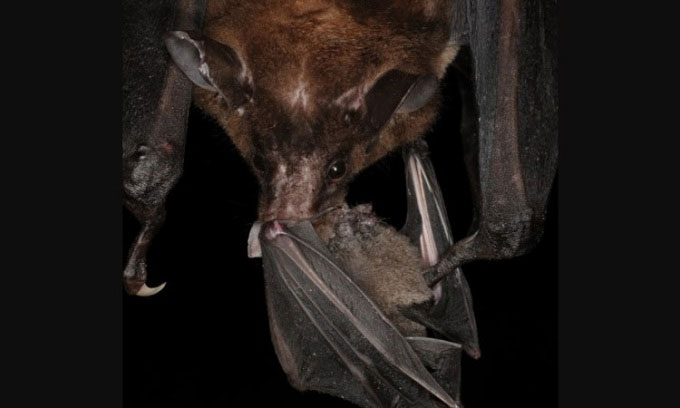The ghost bat is often compared to a winged leopard due to its method of killing prey with a lethal bite to the top of the head or neck, similar to that of a leopard.
Winifred Frick, the scientific director of the nonprofit Bat Conservation International and an ecologist from California, Santa Cruz, examined nets during a bat survey in Belize this year. In a November expedition, the research team encountered dozens of bat species near the archaeological reserve of Lamanai, but none were larger than a songbird. However, the ghost bat (Vampyrum spectrum), the largest bat in the Western Hemisphere, is as big as a raven, with a wingspan that can exceed one meter.

The ghost bat preying on another bat. (Photo: Marco Tschapka)
The ghost bat is sometimes referred to as the false vampire bat because it does not suck blood but rather feeds on flesh. This apex predator hunts rodents, birds, and other bats, occasionally attacking prey mid-flight. Therefore, Frick, who has handled thousands of bats over 20 years, carefully wore thick leather gloves to avoid being bitten.
In the previous week, another netting team captured a female ghost bat. When removing the bat from the net for further examination, Frick was surprised to find several holes in each wing, indicating this was a bat she had previously captured. The hole-punching method is a quick and harmless research technique for collecting genetic samples. The skin will heal rapidly and does not affect flight activity.
“Bats play a crucial role in the mammalian ecosystem. Particularly, the ghost bat is a fantastic example. They are the winged leopards of the rainforests of Central and South America,” Frick said.
Melissa Ingala, a research specialist at the American Museum of Natural History in New York, and her colleagues placed an extremely small tag under the bat’s skin and collected fecal samples to determine what it had recently eaten. If the bat is captured again, the research team can compare the two samples to see how its diet has changed. This information is vital for understanding the animal’s behavior.
Bats typically eat insects, fruit, or pollen, but recent studies have shown that ghost bats are one of nine bat species that can be classified as carnivorous. These bats are top predators in the ecosystem, contributing to the control of prey populations.
From southern Mexico to Brazil, ghost bats fly through the night in search of birds, capturing prey resting on branches or in nests. These flying mammals also catch wandering rodents among the fallen leaves. Like leopards, they often deliver a fatal bite to the top of the head or the back of the neck of their prey. However, scientists rarely witness ghost bats hunting due to their low population density. Habitat loss is also a significant issue. The International Union for Conservation of Nature has classified ghost bats as near threatened.


















































